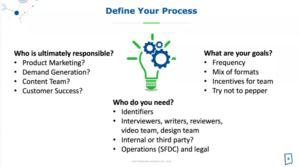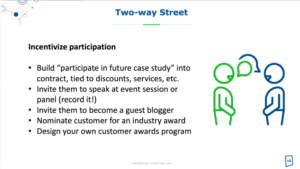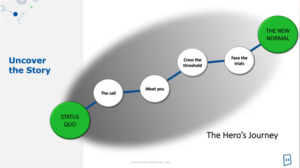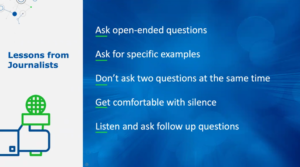
Note: This post was written by Hazel Elizabeth, who provides professional copywriting and content writing.
Did you know over 75% of buyers rely on case studies when making purchase decisions? They convert at the highest rate of any content type. People don’t trust brands, but they do trust other people.

Margie Agin (photo via Twitter)
Detailing real-world experiences from people your prospective customers can relate to can make all the difference between making the sale and not. It’s easier said than done, however, with many B2B companies struggling to get customers to agree to go public with their stories.
Margie Agin spoke at the Bay Area Content Marketing Meetup on how to optimize case studies to build customer trust and influence purchase decisions. Margie is Chief Strategist at Centerboard Marketing.
Developing a case study pipeline
Defining your process will help you to generate an ongoing pipeline of case studies. Answer these questions:
Who is ultimately responsible?
You need to designate one person to be in charge of the process. They can come from these departments:
- Product Marketing
- Demand Generation
- Content Team
- Customer Success

Who else do you need?
Others who are involved in the process need to be aware of their roles and responsibilities, and be prepared to do the work. You need to work out:
- Who are the identifiers? (The ones who will find the story)
- Who’s going to do the interview?
- Who’s going to review it and make sure the story matches the messaging the company wants to highlight
- Who’s going to write it up? (Sometimes the interviewer and the writer can be the same person)
- Are there any design teams or video teams involved?
- Will you use internal or third-party people? Most people will open up more to third parties than to people coming from within the company.
- Who will be your operations and legal team?
What are your goals?
Decide how often you can realistically produce a case study. Next, decide whether it will be a blog, a designed two-pager or a video. Decide on incentives, both for your customers and for your sales team. Figure out all the ways you can use the case study.
Getting customers to agree to the case study
It can be difficult to get customers to agree to be part of a case study. But it’s not impossible. Here are three ways you can approach it.
Ask for non-public feedback
Start with a softer ask. Non-public feedback takes the pressure off of them and it’s often the simplest ask to start with. Examples:
- Customer advisory panels
- Customer surveys
- Win/loss interviews
- Referral programs
- Anonymous peer reviews
- A quick email to ask for opinions.
Incentivize customers

There will be some customers who can’t accept incentives, such as the Federal government. For other organizations, incentives can work well in making things feel less like a one-sided ask:
- Build “participate in future case study” into the contract and tie it to future discounts, renewals or additional services.
- Invite them to speak at an event session or panel (and record it to use later, or to pull a quote from). Get them to talk about their agenda, their own platform. Help them to build their personal brand.
- Invite them to become a guest blogger or offer a quote within a blog.
- Nominate them for an industry award. Make them the hero.
- Design your own customer awards program. This could be at an annual customer event or conference.
Make it easy for customers
People are busy, with little time to spare. The quickest way to get exactly what you need is to make their life easy and do it for them.
Offer support with interviewing, writing, editing, any guidance they might need, design help. Draft a sample quote and have them adjust and approve. Alternatively, draft an email they can send to their boss or to Legal to get approval.
How to structure the case study interview
Use this six-step outline to organize the interview with your customers:

- Life before they met your brand.
- The call or some kind of trigger. Something changed that made them look around for a solution.
- They meet you.
- The crossover to buy into the solution.
- The ups and downs of making the decision, implementing, getting buy-in, reaching success.
- The new normal. The vision that they had and that you helped them paint.
The most important part is the “before” and the “after.” Show that and you’ll have an interesting story.
Journalists are seasoned warriors in the interview battlefield. They know what they’re doing and do it often. Here’s a few tips from journalists that can be really helpful when conducting your interviews:

- Stay away from yes/no questions. Keep it open-ended and encourage them to talk.
- The meat is in the details, so make sure to push for examples. Get them to be specific. If they give you something slightly interesting, ask them to expand on it. And keep on that track until you think you have enough juice to write a good story.
- Pace yourself. It’s easy to run ahead and fire out questions, but if you do that, you’ll miss all the good stuff. Slow it down. Don’t ask a follow-up question when you’re still getting an answer from your first question.
- Silence can be difficult, particularly when you’re on the phone and can’t see the other person’s expression or body language. But people just need time to think before answering, so allow them that time before you press on.
- Listen to what they’re saying to you and be willing to stray from your script. Having a structure is fine, but if you’re completely married to it and aren’t able to change the direction the conversation is going, you’ll never get to the good stuff.
Three questions to ask
The more specific you are with your questions, the more colorful the answers are and the better you can paint the story. Try these:
- If ‘COMPANY’ didn’t exist, how would you try and solve the problem? How would that play out? What would the result be?
- Think back to the day you decided a tool like ‘COMPANY’ was important. What was special about that day? Why didn’t you act sooner?
- What do you tell your executive team when they say “was this solution worth it?”
How to use the case studies
Now comes the fun part. It’s time to put the great customer stories you’ve collected into action. Here are ways to use them:
A slide within a sales deck
Have a customer quote as the centerpiece. Screen captures from videos work better than a professional headshot from LinkedIn, as it helps the prospective customers better relate to the story.
SEO-friendly web pages
Customer case studies are great for SEO, because they often contain high-quality keywords and keyphrases. Make the case studies ungated and make it easy for visitors to browse and read them. If you turn the web content into a two-page print piece for an event, make it easy to skim.
Storytelling blog posts
Get people’s attention right away with a snippet of what’s to come, then make it relatable to the same struggles prospective buyers are going through.
Customer videos
Getting customers to appear on video requires an additional approval step, as well as more logistics and production. However, seeing customers on camera can be more compelling than reading quotes from them in a written case study.
On-demand recording
Watch the full recording of Margie’s talk:
